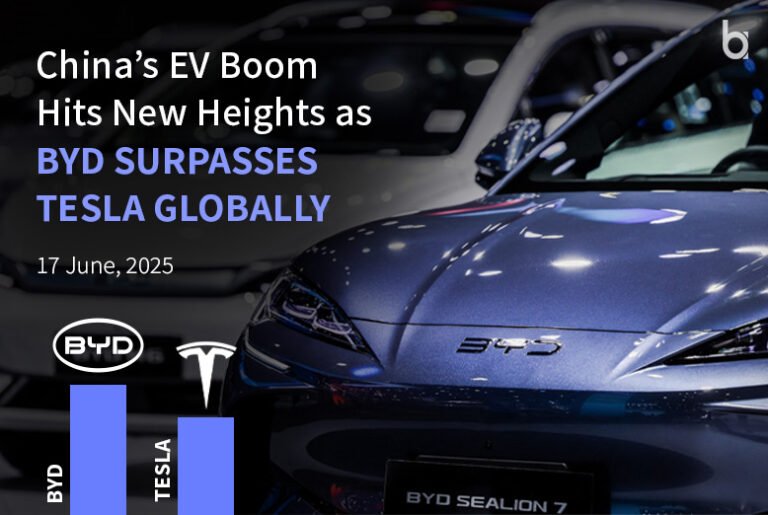Business APAC
June 17, 2025
China’s electric vehicle revolution continues its remarkable ascent, driven by surging domestic demand and strategic global expansion. According to the latest data from the International Council on Clean Transportation (ICCT), Chinese manufacturers now sell over 11 million EVs annually, accounting for more than half of the world’s total EV market. In a historic moment earlier this year, monthly EV sales in China exceeded one million units for the first time.
BYD Overtakes Tesla in a Global Showdown
A standout development in this EV narrative is BYD’s rapid rise. In 2024, BYD overtook Tesla in global battery-electric vehicle (BEV) sales, achieving a 25% year-on-year increase in BEVs, along with a 47% jump in total BEV + PHEV sales. Data from May shows BYD dominating China’s NEV (New Energy Vehicle) market with a 28.5% share, while Tesla slipped to eighth place at just 3.8%.
In Europe, BYD’s momentum is unmistakable. April 2025 marked the first month BYD outpaced Tesla with 7,231 BEV registrations, compared to Tesla’s 7,165.JATO Dynamics’ Felipe Munoz called it a “watershed moment”—a sign of shifting dynamics in a market long dominated by Tesla.
How China’s Strategy Transforms the EV Landscape
- Full supply-chain control: Chinese firms like BYD have vertically integrated operations—from battery production to autonomous driving software—enabling lower costs and faster innovation.
- Ultra-fast charging: BYD’s “Blade” batteries paired with 1,000 kW charging systems can charge vehicles from 16% to 80% in just minutes.
- Affordable smart EVs: BYD includes its advanced “God’s Eye” driver-assist tech by default in $30,000 models, undercutting Tesla’s $9,000 FSD upgrade.
- Government and scale: China’s dual-credit EV policies and robust domestic demand have supported breakeven—and then dominance—for companies like Geely, SAIC, and BYD, some reaching their 2025 targets early.
Expansion Beyond the Great Wall
Chinese automakers are aggressively expanding. In May, global EV demand climbed 24%, largely fueled by a record-breaking China market month that topped 1 million EVs sold. BYD has increased exports to markets like Mexico, Southeast Asia, Uzbekistan, and secured a strong presence in Africa—it plans to triple its South African outlets by 2026.
Europe remains a key battleground. BYD is launching its budget Dolphin Surf model in the UK for £18,650, aiming directly at Tesla’s lead.
To support this surge, BYD is investing €4 billion ($4.5 billion) in a manufacturing plant in Hungary—capable of producing 200,000 vehicles annually—slated to open in late 2025.
Tesla’s Lag and China’s Tech Advantage
Meanwhile, Tesla is facing fortified competition. In China, May deliveries of locally-built Model 3 and Y vehicles fell by 15% year-on-year. In Europe, Tesla’s Model Y registrations plunged nearly 49% in April, overshadowed by BYD’s 169% surge.
China’s EV brands are also gaining ground in autonomous driving technology. With features like radar and lidar, BYD’s driver-assist systems outperform Tesla’s pricier FSD and command a technological lead.
What This Means for the EV Ecosystem
China’s EV boom isn’t just about selling cars—it represents a systemic transformation:
- Reinvestment in R&D and local manufacturing is fostering globally competitive innovation ecosystems.
- The country’s dominance in EVs—accounting for 57.5% of global BEV and 69.4% of PHEV sales—positions it as a tech leader for the 2030s.
- For global automakers, the message is clear: accelerate EV transformation or risk being left behind.
Final Word
China’s EV boom, anchored by BYD’s meteoric rise, is reshaping the global auto market. With groundbreaking technology, massive scale, and strategic expansion, Chinese EV brands are rewriting the rules. As Tesla grapples with lagging sales and mounting geopolitical headwinds, one thing is certain: we’re witnessing a new chapter in China’s EV Boom—and it’s only just begun.



